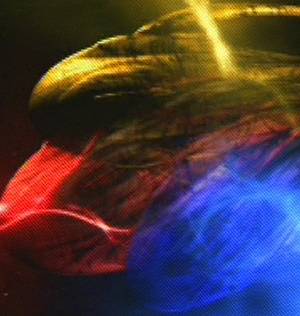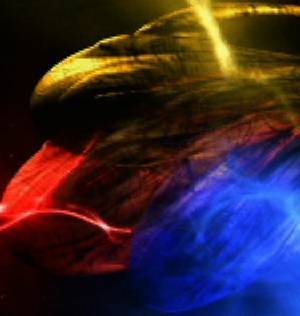

Once I had my first video done, I recorded it to my DV camcorder and then to the vastly inferior VHS analog tape. The tape went off to the Farscape convention people, in hopes they'd be as impressed as I was. Since there was still time before the convention deadline, and since their rules permitted the submission of two videos, I went back to work. This time I decided to go for something lighter.
As I've written elsewhere,
I'm a big fan of musical
theatre. And as I searched my memory for an appropriate song for my next
video, I kept coming back to a revival of
How To Succeed In Business Without Really Trying
that I'd seen on Broadway a few years back. Thinking about
the dynamic of some of Farscape's relationships (and the fact that I hadn't
found a place for any of the show's villains in my first video), I got the
idea of using a song from HT$ called I Believe In You. There's a bit of
irony to the song, as it's sung by Matthew Broderick's J. Pierpont Finch
to himself, with a chorus of the other executives singing about their need
for him to fail. Translating it to Farscape wasn't much of a leap,
logically speaking:
(This is the 29.6 MB version of the movie. The lower quality version is 5.1 MB.)
Putting this video together didn't take quite as long as Wonderful World. In part, that was because I had a better idea of the process I was using and because I'd been through all the video and kind of knew where to find the clips I wanted. But I also got more experimental, taking advantage of iMovie's ability to extract the audio from a video clip and combine it with my music track. And I played around with duplicating and reversing some of the video. But the best bits in this video came about by accident. Like when I noticed how the timing of a musical cue in the song happened to match a character's blink. Or that a first clip of Scorpius talking seemed to match the singing. Or at least it was enough of a match to get a laugh.
One big limitation of iMovie is that you can't lay down video tracks wherever you want in the timeline; you have to construct it from start to finish with no gaps to be filled in later. I got around this limitation by creating big chunks of black screen video of just the right length (number of seconds/frames). That let me work on parts of the song out of sequence, although it wasn't nearly as convenient as it ought to be. But on balance, I think iMovie is absolutely amazing. And the price is right, assuming you're clever enough to have a Macintosh running Mac OS X. If an untutored amateur like me can produce results like this, imagine what somebody with talent could do.
Oh, and in case you were wondering: both videos were selected to be performed at the 2002 Farscape Convention in Burbank. And I've heard that one was also played at the New York con the following weekend. So the time and effort was most definitely worth it.
The preceding discussion may have you wondering. Why, you may wonder, did I go to the bother of converting digital video from a DVD to analog, just to convert it back to digital? Surely there's a penalty to be paid for those two conversions in terms of image quality. Wouldn't it be better to keep the data digital right up until the end?
You're right, of course. (Although I really would prefer that you didn't call me Shirley.) There was one good reason why I took the digital-analog-digital approach: I didn't know how to do it any other way. Now I do; there's a freeware program called OSeX that will take a video track from a DVD and remove the CSS encryption from it. And once you've done that, you can use Quicktime Pro to convert the MPEG 2 video to DV format and import it into iMovie.
But there are two problems with this approach. The first problem is that these conversions are slow. Converting fifteen minutes of video takes upwards of an hour on my admittedly not state-of-the-art 667MHz PowerBook. (And neither the OSeX nor the Quicktime Pro conversion steps will work on less than a chapter's worth of video.) So the incredible immediacy of capturing video with the Formac Studio is lost.
Still, the quality is much greater with the all-digital conversions. And it avoids a lightening of the image that occurs somewhere in the digital to analog to digital conversion process. You can see the differences in quality and in brightness in the frames below:
| An analog-converted frame | An all-digital frame |
|---|---|
 |
 |
The second problem with going all digital is a difference in brightness that shows up when I export a Quicktime movie; movies made with an analog conversion look fine but those made with the all digital process are way too dark. Interestingly, exporting a movie to my digital camcorder produces the correct brightness using either method. And with my new SuperDrive-equipped PowerBook, I can produce spectacular looking DVDs as well. Which led me to a solution for the darkness problem - take the DV movies generated by iMovie for iDVD and then use Quicktime Pro to convert them to smaller movie files. Unlike the export from iMovie, these Quicktime files have the right brightness.
My next video took me back to where I began: with a holiday slideshow. This time the subject was New Zealand, which I visited in April of 2003. Lacking a distinctly Kiwi piece of music for a soundtrack, I opted for a couple of tracks from Howard Shore's Lord Of The Rings music. I think it turned out pretty well.
(This is the 43.8 MB version of the movie. The lower quality version is 15.5 MB.)
The story continues on the next page...